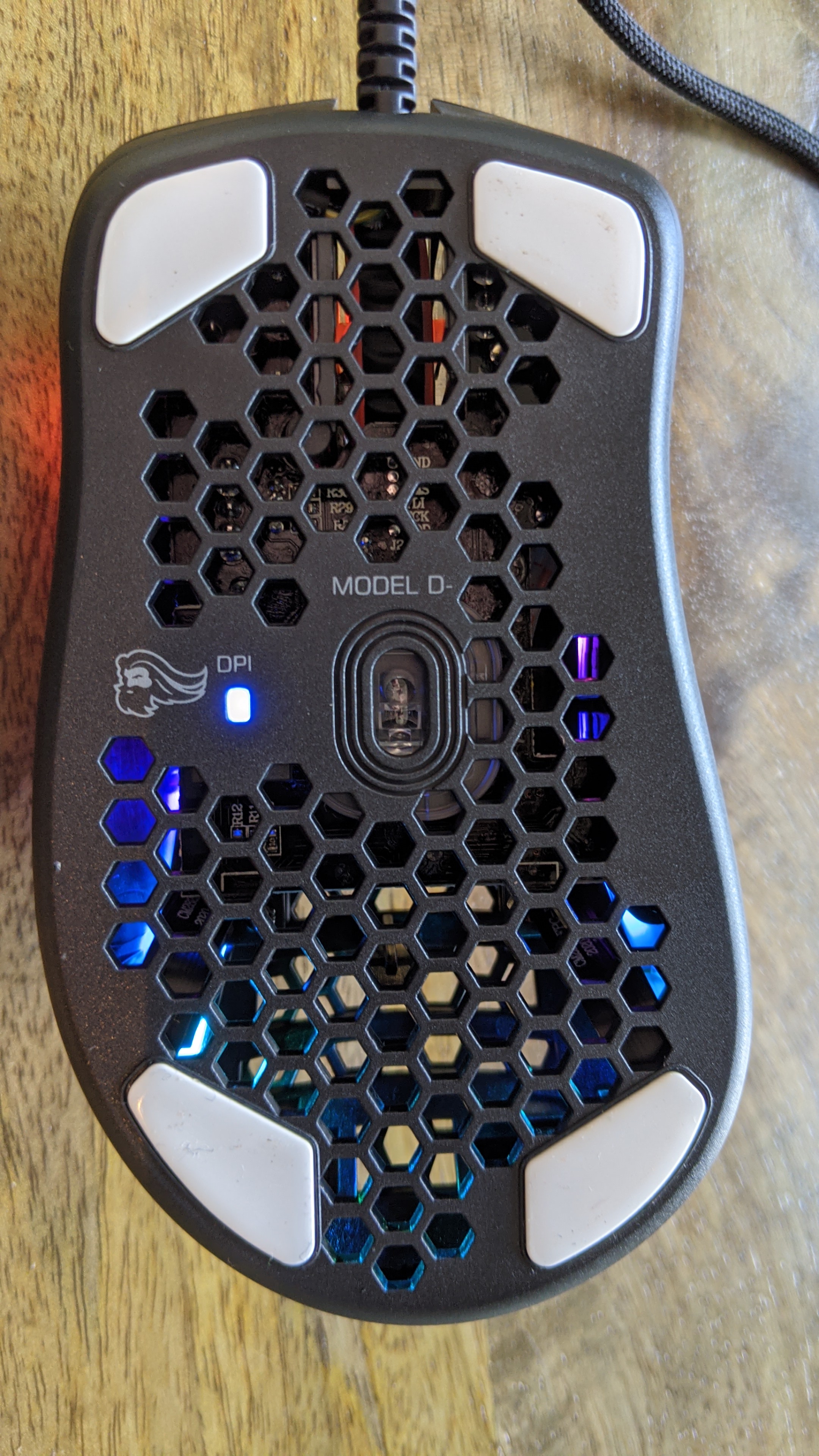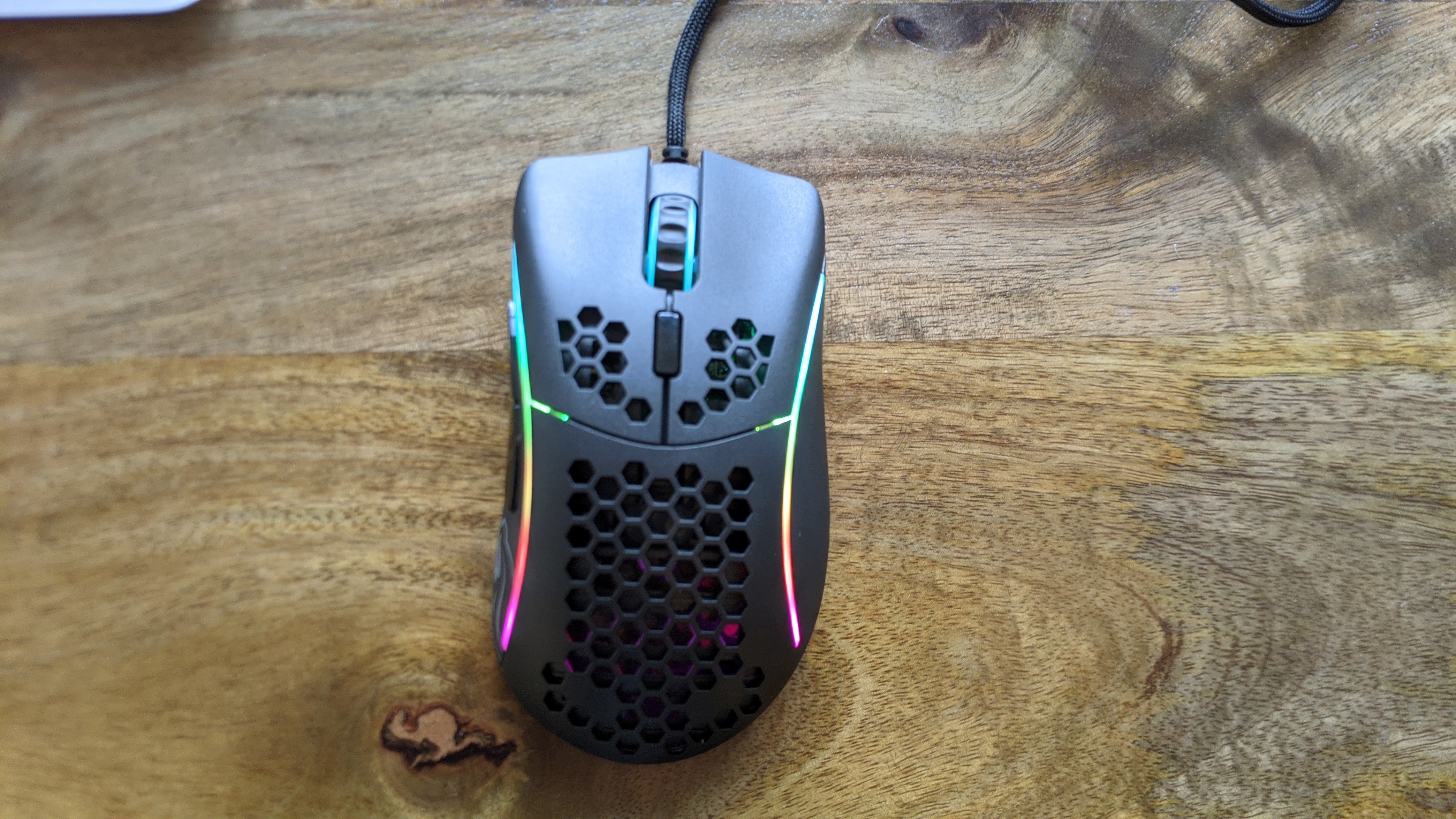Tom's Hardware Verdict
The Glorious Model D- is a lightweight juggernaut offering smooth sensor performance in a design that performs well for gamers. There’s slight movement in the left and right buttons, but it's otherwise one of the best options for a small gaming mouse.
Pros
- +
Lightweight
- +
Excellent sensor and switches
- +
Top-quality PTFE feet
- +
Ergonomic shape
Cons
- -
Some button wobble
- -
Not for lefties
- -
Once again, that branding
Why you can trust Tom's Hardware
If you play a lot of MMOs or MOBAs, you’re probably looking at the gaming mouse market from a different angle than Glorious. The subreddit-inspired peripherals maker has a focus on lightweight rats with simple button layouts that look to be the best gaming mouse for shooters and battle royales where the fastest trigger finger wins.
The Glorious Model O and its smaller counterpart, the Glorious Model O-, provide a symmetrical, IntelliMouse-style solution for those who prefer the lower profile, as well as southpaws. The Glorious Model D and this smaller Glorious Model D- in question scrap the symmetry for an ergonomic design. As such, there’s very little difference between the specs of all Glorious’ range until you get to the dimensions. All are incredibly light and decked out with impressively sharp RGB lighting and attention to detail throughout the componentry that sets them apart from the market. From the PTFE feet to the sensors and buttons, the Model D- continues this tradition, offering a sense of quality above its $50 price tag.
Glorious Model D- Specs
| Sensor | Pixart PMW3360 |
| Sensitivity | 12,000 CPI |
| Polling Rate | 1,000 Hz |
| Programmable Buttons | 6 |
| LED Zones | 3x RGB |
| Connectivity | USB Type-A |
| Cable | 6.5 feet (2m) |
| Weight | 2.15 ounces (61g) |
| Dimensions (LxWxH) | 4.72 x 2.40-2.64 x 1.30-1.57 inches (120 x 61-67 x 33-40mm) |
Design of Glorious Model D-


How much you dig the look of any Glorious mouse will depend on your tolerance for its honeycomb surfaces. In the name of weight-saving, the body and half of the left and right mouse buttons are covered in roles, exposing the PCB within. Our review unit came in black, but you can also get the rat in white.
That design’s certainly effective at keeping the weight down. The Model D- weighs just 2.15 ounces (61g) for the grippy, but not tangibly porous matte, version we’re testing or 2.19 ounces (62g) for the glossy finish (who knew glossy plastic weighed that much more?). That’s a savings of about 0.25 ounces (7g) over the larger Glorious Model D. It’s also lighter than the HK Gaming Mira-M (2.22 ounces), another honeycomb-style mouse. The Glorious Model O-, however, is lighter (2.08 ounces) than the Model D-. While you’re not trying to cycle these things up Alpe d’Huez, the weight does carry a tangible benefit when you’re playing twitch-shooters like Quake Champions.
Not surprisingly the Model D- is shorter in length and height at its trimmest points (4.72 x 2.40 x 1.30 inches) than the Model D (5.04 x 2.40 x 1.65 inches), as well as the Mira-M (4.88 x 2.52 x 1.55 inches). The Model O- is less wide and slightly taller than our review focus. Glorious’ Model D- definitely isn’t ambidextrous, but you probably knew that the moment you saw its lopsided shape.
Omron mechanical switches for the left and right buttons and G-Skates branded PTFE feet keep the Model D- zippy and precise. Meanwhile, a simple six-button layout provides just enough inputs for the shooter player. All these buttons (the left and right click buttons, two side buttons, scroll wheel in and CPI button south of the wheel) are programmable via Glorious’ software.
There are three RGB zones on the Model D-: along each side and on the scroll wheel. Are all customizable via Glorious’ own software (more on that later). These RGB zones are pin-sharp. When I first plugged in the mouse, a rainbow effect took over by default. It was genuinely impressive how many individual regions there were along those bands of RGB.
Get Tom's Hardware's best news and in-depth reviews, straight to your inbox.
Less visually appealing is the branding on the Model D-. The snooty reputation of the so-called Glorious PC Gaming Race is embodied through a picture of its mascot where your thumb goes, as well as on the mouse’s underside. There’s also a more forgivable and smaller “Glorious” stamp on the right side.
The Model D- has left and right click buttons that are scalloped and flayed outwards, providing a more ergonomic grip whatever your preferred stance, so to speak, when holding a mouse. While this was a comfortable shape for my performing digits, the design does open the door to some lateral movement from both buttons. This was also a very slight bugbear on earlier iterations of the Model O and Model D. The quality of the switches underneath and the rigidity of the plastic outer means that wobble is unlikely to result in an accidental button press, but players who are particular about firmer lateral movement should be aware.
Gaming Performance of Glorious Model D-

Let’s start by stating the obvious: The Model D- isn’t the perfect mouse for trying to run a World of Warcraft raid or fly a plane in the new Microsoft Flight Simulator. Its six-button layout is intended very much for shooters, and it’s in shooters where our testing primarily lies.
Glorious packed the Model D- with a Pixart PMW 3360, as it did with the other mice in its Model lineup. This sensor can be set to a sensitivity of up to 12,000 CPI and has a max velocity of “250-plus” IPS and can handle up to 50G of acceleration.
CS:GO is one of the purest tests of raw mouse input skill available in competitive gaming. As such, it’s a trial by fire for any mouse. We found the Pixart sensor in the Model D- to be super-reliable at lower CPI settings. This reviewer’s preference is 400 CPI, and at such a low sensitivity you need to make big motions across the mouse pad when turning or flick-aiming. That’s where the unusual quality of Glorious’ PTFE feet really sing. The smoothness in motion couldn’t be better if Glorious sent a zamboni over to roll over your mouse between rounds.
Quake Champions tells a similar story. It’s all about fast pace and high skill, and I also tackled this game with a low CPI setting. Again, the Model D-’s favorable assets -- its light weight, shape, sensor, feet and switches -- all combined just as you’d want them to. Outside of those slightly wiggly buttons, there’s nothing about the Model D- that’s crying out to be tweaked or modified.
Unfortunately, the indicator light that alerts you to what CPI setting you’re using is on the mouse’s underside. This can be a real pain if you like to switch between two settings for assault rifles and sniper rifles, for example, or keep a super-low DPI for railgunning in Quake. You can get around this by setting all six steps available to one of two values.
The scroll wheel in this model, as with other Glorious mice, has a notched scroll style and doesn’t feature inputs by nudging it to either side. It proved well-suited to shooters too. In these games, you want clearly defined scroll inputs for changing weapons or zoom levels but don’t want to accidentally fire off your special with a heavy-handed nudge.
In terms of physical features, the Glorious’ cable design here shows a tighter fit around the internal wires than the Model O had, which is good news, since some users reported connection problems with that design. We’ve had no such trouble with the cable on our test unit. And the cable did feel lighter and freer than a traditional braided fabric cable.
Features and Software of Glorious Model D-

The software component to your Glorious Model D- is simple, clean and includes all the features you’d want. Most significant is the adjustable debounce time, defaulting to 10ms but recommended at 4ms. Debounce is basically the cooldown time after your switch registers an input, so if you like to tap rapidly to negate weapon recoil, it’s worth making this value quicker.
RGB customization here is comprehensive. There are probably enough options here to keep a Broadway stage lighting engineer occupied, but suffice it to say a number of preset behaviors are loaded into the software and can be modified with the gazillion colors within the RGB spectrum. DPI steps are adjustable here too, as are the colors that demark them via the indicator light on the mouse’s underside.
Bottom Line

Once again, Glorious sticks to a winning formula. The Glorious Model D- is an ergonomic mouse for smaller hands and the weight obsessed that complements the brand’s symmetrical Model O mice and the larger Model D.
The gripes here are pretty miniscule. There’s some button wobble if you really look for it, and a DPI indicator on the underside of the mouse. But there’s also the issue of the manufacturer branding, which shouldn’t go completely without mention. Unlike the subreddit name, the “Master” has been dropped from Glorious PC Gaming Race’s name, but that doesn’t mean it’s free of the same tasteless connotations. It felt uncomfortable when the first Glorious mice arrived and still does. If you’re looking for something with less heavy branding, the HK Gaming Mira-M offers a similar, lightweight gaming experience while being ambidextrous.
Choosing between the Model D- and Model O- will come down to comfort, and that depends on your hand, shape, size and grip. Both Minus models will feel more comfortable to smaller hands and claw grips. The larger variants will fill out a palm nicely for palm and hybrid grip players, and are naturally better suited to larger digits and pads. Plus, the Model D- is lighter than the Model D.
And when it comes to the D or O shape, you’ll probably feel more at home with one than the other, based on the shape you’ve spent more time with. My hand is permanently molded around a Microsoft IntelliMouse shape now, so the O feels like home. If you spent your formative years with an asymmetrical shape, the D is better suited. And if you don’t like RGB, Zowie’s FK range is still your best bet.
But if you like RGB and want a small, well-performing gaming pointer, the Model D- is an A+ option.
-
Phaaze88 I've seen these before, but how practical are these - the holes, I mean?Reply
Aren't they just a trap for filth(dirt, dead skin cells, sweat...)? I know it happens with normal mice, but isn't this worse? -
vinay2070 Reply
Yup, reminds me of inside of the cabinet ;)Phaaze88 said:I've seen these before, but how practical are these - the holes, I mean?
Aren't they just a trap for filth(dirt, dead skin cells, sweat...)? I know it happens with normal mice, but isn't this worse? -
Phaaze88 Reply
Eww. Thanks for the unwanted visual...vinay2070 said:Yup, reminds me of inside of the cabinet ;) -
hotaru.hino Reply
"Real gamers" play with gloves ;)Phaaze88 said:Aren't they just a trap for filth(dirt, dead skin cells, sweat...)? I know it happens with normal mice, but isn't this worse? -
richardvday Points for the Alpe d’Huez reference!Reply
When you say you can see the pcb you mean like literally ? Like if my one year old spilled some soda on it poof ?